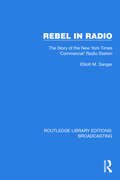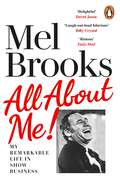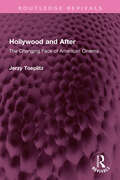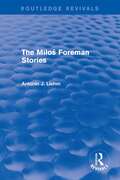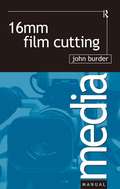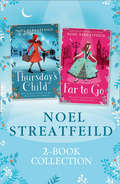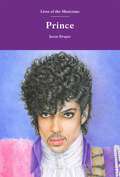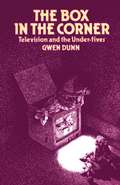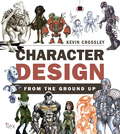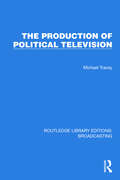- Table View
- List View
Rebel in Radio: The Story of the New York Times 'Commercial' Radio Station (Routledge Library Editions: Broadcasting #30)
by Elliott M. SangerRebel in Radio (1973) looks at the story of WQXR, the rebel New York commercial radio station. It examines WQXR’s place in broadcasting history, and how, at a time when American commercial radio had become but a pawn of the advertising industry, it showed that a radio station could be competitive and still maintain high programme and advertising standards.
Voice And The Actor
by Cicely BerryVoice and the Actor is the first classic work by Cicely Berry, Voice Director of the Royal Shakespeare Company and world-famous voice teacher. Encapsulating her renowned method of teaching voice production, the exercises in this straightforward, no-nonsense guide will develop relaxation, breathing and muscular control - without which no actor or speaker can achieve their full potential. Illustrated with passages used in Cicely Berry's own teaching, Voice and the Actor is the essential first step towards speaking a text with truth and meaning. Inspiring and practical, her words will be a revelation for beginner and professional alike.
All About Me!: My Remarkable Life in Show Business
by Mel BrooksAVAILABLE NOW'Delightful. A great, fun read.' DAVID JASON'Mel Brooks is the king of comedy.' DAVID BADDIEL'A comic genius.' SIMON PEGG'Convivial and chirpily amusing...Wisecracking Mel's journey from tragedy to comedy.' TELEGRAPH'Riotous' DAILY MAILAt 95, the legendary Mel Brooks continues to set the standard for comedy across television, film, and the stage. Now, for the first time, this EGOT (Emmy, Grammy, Oscar, Tony) winner shares his story in his own words.'Not since the Bible have I read anything so powerful and poignant. And to boot - it's a lot funnier!' - M. BrooksFor anyone who loves American comedy, the long wait is over. Here are the never-before-told, behind-the-scenes anecdotes and remembrances from a master storyteller, filmmaker, and creator of all things funny.All About Me! charts Mel Brooks's meteoric rise from a Depression-era kid in Brooklyn to the recipient of the National Medal of Arts. Whether serving in the United States Army in World War II, or during his burgeoning career as a teenage comedian in the Catskills, Mel was always mining his experiences for material, always looking for the perfect joke. His iconic career began with Sid Caesar's Your Show of Shows, where he was part of the greatest writers' room in history, which included Carl Reiner, Neil Simon, and Larry Gelbart. After co-creating both the mega-hit 2000 Year Old Man comedy albums and the classic television series Get Smart, Brooks's stellar film career took off. He would go on to write, direct, and star in The Producers, The Twelve Chairs, Blazing Saddles, Young Frankenstein, Silent Movie, High Anxiety, and Spaceballs, as well as produce groundbreaking and eclectic films, including The Elephant Man, The Fly, and My Favorite Year. Brooks then went on to conquer Broadway with his record-breaking, Tony-winning musical, The Producers.All About Me! offers fans insight into the inspiration behind the ideas for his outstanding collection of boundary-breaking work, and offers details about the many close friendships and collaborations Brooks had, including those with Sid Caesar, Carl Reiner, Gene Wilder, Madeleine Kahn, Alfred Hitchcock, and the great love of his life, Anne Bancroft.Filled with tales of struggle, achievement, and camaraderie (and dozens of photographs), readers will gain a more personal and deeper understanding of the incredible body of work behind one of the most accomplished and beloved entertainers in history.
Closely Watched Films (Routledge Revivals): The Czechoslovak Experience
by Antonín J. LiehmFirst published in 1974, this book collects interviews with leading Czechslovak filmmakers conducted mostly between 1967 and 1969. This was a period of immense upheaval beginning with the attack of the Czechoslovak establishment on the Union of Writers in 1967, continuing through the liberalisation of the Prague Spring in January 1968 and ended with the Soviet invasion in August and subsequent ‘Normalization’ process in April 1969. It records the testimony of several generations of filmmakers and their attempts to answer the questions about the purpose and meaning of film before and during this period. This book will be of interest to students of film and cultural history.
Closely Watched Films (Routledge Revivals): The Czechoslovak Experience
by Antonín J. LiehmFirst published in 1974, this book collects interviews with leading Czechslovak filmmakers conducted mostly between 1967 and 1969. This was a period of immense upheaval beginning with the attack of the Czechoslovak establishment on the Union of Writers in 1967, continuing through the liberalisation of the Prague Spring in January 1968 and ended with the Soviet invasion in August and subsequent ‘Normalization’ process in April 1969. It records the testimony of several generations of filmmakers and their attempts to answer the questions about the purpose and meaning of film before and during this period. This book will be of interest to students of film and cultural history.
Expert Card Technique: Close-up Table Magic (Dover Magic Bks.)
by Jean Hugard Frederick BrauéIf you have ever tried to do a card trick and failed, you know what it is to be embarrassed. You may try to cover up by doing a more difficult trick and fail again. The way out of this dilemma, however, is not immediate, but it is reliable: a surer mastery of technique. This means the proper instruction book, and practice.In this definitive work on card technique, step-by-step instructions teach you the correct methods for the basic manipulations and the more advanced flourishes, and only then allow you to learn tricks. Offering the most foolproof methods available, Jean Hugard and Fredrick Braue explain such basic manipulations as the palm, the shuffle, the lift, the side slip, the pass, the glimpse, the jog, and the reverse. They detail various false deals, crimps, and changes and the more advanced execution needed for forces, fans, and the use of the prearranged deck. Also presented is a wide variety of tricks, including discoveries, self-working tricks, one-handed tricks, stranger cards, and such individually famous tricks as the four aces, the rising cards, and the Zingone spread. In addition, the authors include a complete compendium of shakedown sleights — to warn the card player and aid the entertainer — and a performer's guide to misdirection and patter.Many of the methods explained were revealed here for the first time, while many previously known tricks are presented in improved versions. In every case the aim is simplicity of technique for the purpose of mystifying an audience, not technique for the sake of technique. An unsurpassed collection of methods and manipulations, this classic work will help any aspiring magician to achieve expert card technique.
The Godfather, Part II (BFI Film Classics)
by Jon LewisFrancis Ford Coppola's The Godfather, Part II (1974) is a magisterial cinematic work, a gorgeous, stylized, auteur epic, and one of the few sequels judged by many to be greater than its predecessor. This despite the fact that it consists largely of meetings between aspiring 'Godfather' Michael Corleone and fellow gangsters, politicians and family members. The meetings remind us that the modern gangster's success is built upon inside information and on strategic planning. Michael and his father Vito's days resemble those of the legitimate businessmen they aspire or pretend to be. Jon Lewis's study of Coppola's masterpiece provides a close analysis of the film and a discussion of its cinematic and political contexts. It is structured in three sections: “The Sequel,” “The Dissolve,” and “The Sicilian Thing” – accommodating three avenues of inquiry, respectively: the film's importance in and to Hollywood history, its unique, auteur style and form; and its cultural significance. Of interest, then, is New Hollywood history, mise-en-scene, and a view of the Corleone saga as a cautionary capitalist parable, as a metaphor of the corruption of American power, post-Vietnam, post-Watergate.
Hollywood and After: The Changing Face of American Cinema (Routledge Revivals)
by Jerzy ToeplitzFirst published in English in 1974, Hollywood and After presents contemporary cinema in all its complexity, describing and analyzing the various factors which, in the sixties and seventies, brought so many changes both inside Hollywood and throughout the film industry of the USA. The film industry has been restructured. No longer independent, it now forms only a part, sometimes only a small and secondary part, of large diversified corporations. Formerly rivals, today cinema and television not only coexist, but are forced to cooperate closely in a world of technical developments such as videocassettes, cable TV, and satellite transmissions. The main part of this book is dedicated to artistic and creative questions. A new generation of film makers is making films for a new generation of film goers who are looking for fresh values on the screen. More and more the cinema mirrors the reality of American life: complicated, uneasy, shaken by violent outbursts, charged with a multitude of controversies and conflicts. The rose-tinted American dream, which Hollywood peddled, is a thing of the past. Today the US cinema offers a variety of artistic, political, and social approaches and a wide range of highly individual styles. In the world of social media, OTT platforms, and AI, this book is an important historical reference for scholars and researchers of film studies, film history, and media studies.
Hollywood and After: The Changing Face of American Cinema (Routledge Revivals)
by Jerzy ToeplitzFirst published in English in 1974, Hollywood and After presents contemporary cinema in all its complexity, describing and analyzing the various factors which, in the sixties and seventies, brought so many changes both inside Hollywood and throughout the film industry of the USA. The film industry has been restructured. No longer independent, it now forms only a part, sometimes only a small and secondary part, of large diversified corporations. Formerly rivals, today cinema and television not only coexist, but are forced to cooperate closely in a world of technical developments such as videocassettes, cable TV, and satellite transmissions. The main part of this book is dedicated to artistic and creative questions. A new generation of film makers is making films for a new generation of film goers who are looking for fresh values on the screen. More and more the cinema mirrors the reality of American life: complicated, uneasy, shaken by violent outbursts, charged with a multitude of controversies and conflicts. The rose-tinted American dream, which Hollywood peddled, is a thing of the past. Today the US cinema offers a variety of artistic, political, and social approaches and a wide range of highly individual styles. In the world of social media, OTT platforms, and AI, this book is an important historical reference for scholars and researchers of film studies, film history, and media studies.
The Miloš Forman Stories (Routledge Revivals)
by Antonín J. LiehmFirst published in 1975, this book examines the career of one of the leading post-war Czech filmmakers Miloš Forman through his own testimony. After recollecting his childhood and early artistic ventures, Forman gives accounts of the making of his major films, interspersed with contemporaneous reviews by the author, and in the final chapter he sums up his ‘lessons along the way’. A section entitled ‘Stories behind the Stories’ fills in details on the events and people mentioned in Forman’s narrative. The author’s commentary provides valuable insights not only into the aesthetics of filmmaking but also the social and political environment in contemporary Czechoslovakia.
The Miloš Forman Stories (Routledge Revivals)
by Antonín J. LiehmFirst published in 1975, this book examines the career of one of the leading post-war Czech filmmakers Miloš Forman through his own testimony. After recollecting his childhood and early artistic ventures, Forman gives accounts of the making of his major films, interspersed with contemporaneous reviews by the author, and in the final chapter he sums up his ‘lessons along the way’. A section entitled ‘Stories behind the Stories’ fills in details on the events and people mentioned in Forman’s narrative. The author’s commentary provides valuable insights not only into the aesthetics of filmmaking but also the social and political environment in contemporary Czechoslovakia.
Picnic at Hanging Rock (BFI Film Classics)
by Anna Backman RogersPeter Weir's haunting and allusive Picnic at Hanging Rock (1975), set in 1900, tells the story of the mysterious disappearance of three schoolgirls and their teacher on a trip to a local geological formation. The film is widely hailed as a classic of new Australian cinema, seen as exemplary of a peculiarly Australian style of heritage filmmaking.Anna Backman Rogers' study considers Picnic from feminist, psychoanalytic and decolonialising perspectives, exploring its setting in a colonised Australian bushland in which the Aboriginal people are a spectral presence in a landscape stolen from them in pursuit of the white man's 'terra nullius'. She delves into the film's production history, addressing director Weir's influences and preoccupations at the time of its making, its reception and its lasting impact on visual culture more broadly. Rogers addresses the film's treatment of the young schoolgirls and their teachers, seemingly, as embodiments of an archetype of the 'eternal feminine', as objects of the male gaze, and in terms of ideas about female hysteria as a protest against gender norms. She argues that Picnic is, in fact, highly subversive: a film that requires its viewers to read its seductive surfaces against the grain of the image in order to uncover its psychological depths.
16mm Film Cutting (Media Manuals Ser.)
by John BurderThe film editor can make or break a film. What ends up on the cutting room floor, and why? 16mm Film Cutting is a step-by-step guide to film cutting which shows you how to achieve professional results.The practical side of the editor's job is clearly described and illustrated; breaking down rushes and making a simple join, identifying shots, first assembly, avoiding errors, preparing special effects, instructing the labs, compiling sound tracks and all the other stages in producing the final film. 16mm Film Cutting is an indispensable aid to editors and assistants working in all areas of 16mm film production.
16mm Film Cutting
by John BurderThe film editor can make or break a film. What ends up on the cutting room floor, and why? 16mm Film Cutting is a step-by-step guide to film cutting which shows you how to achieve professional results.The practical side of the editor's job is clearly described and illustrated; breaking down rushes and making a simple join, identifying shots, first assembly, avoiding errors, preparing special effects, instructing the labs, compiling sound tracks and all the other stages in producing the final film. 16mm Film Cutting is an indispensable aid to editors and assistants working in all areas of 16mm film production.
Noel Streatfeild 2-book Collection: Thursday's Child And Far To Go
by Noel StreatfeildJoin the unforgettable heroine Margaret Thursday as she makes her way from an orphanage to the stage in this ebook collection containing the classic novels Thursday’s Child and Far to Go by Noel Streatfeild, the beloved author of Ballet Shoes.
Prince (Lives of the Musicians)
by Jason DraperHis name was Prince, and he was funky. He was also inspiring, infuriating, visionary and otherworldly. Channelling contradictions in search of his own unique truth, he eventually changed his name to an unpronounceable glyph that merged the male and female symbols in an outward expression of his inner dualities. Gifted with the ability to play almost every instrument on his records, and shifting between musical styles as much as he switched-up his looks, he refused to acknowledge boundaries. Instead, he brought opposing forces together in a life-long quest to reconcile a dirty mind with a love for God. In doing so, the mini Minneapolis genius became a world-conquering icon whose towering legacy continues to shape pop culture.
Telecommunications: A Systems Approach (Routledge Library Editions: Broadcasting #33)
by G. Smol M.P.R. Hamer M.T. HillsTelecommunications: A Systems Approach (1976) uses two extended case studies, of public telephone and television systems, in order to introduce the basic ideas of telecommunication systems. It describes the application of a number of techniques within the context of practical telecommunications systems, and takes into account the needs of the users of these systems and the economic constraints which affect the choice of techniques and the overall system structure.
Telecommunications: A Systems Approach (Routledge Library Editions: Broadcasting #33)
by G. Smol M.P.R. Hamer M.T. HillsTelecommunications: A Systems Approach (1976) uses two extended case studies, of public telephone and television systems, in order to introduce the basic ideas of telecommunication systems. It describes the application of a number of techniques within the context of practical telecommunications systems, and takes into account the needs of the users of these systems and the economic constraints which affect the choice of techniques and the overall system structure.
Broadcasting in Canada (Routledge Library Editions: Broadcasting #13)
by E.S. Hallman H. HindleyBroadcasting in Canada (1977) examines the unique challenges to broadcasting in the country: the size of the country, its small, dispersed population, and two official languages make radio and television coverage a difficult and costly enterprise. These conditions and pressures have led Canadians to construct a broadcasting system in which both public and private initiative have roles to play in bringing radio and television services to the community.
Broadcasting in Canada (Routledge Library Editions: Broadcasting #13)
by E.S. Hallman H. HindleyBroadcasting in Canada (1977) examines the unique challenges to broadcasting in the country: the size of the country, its small, dispersed population, and two official languages make radio and television coverage a difficult and costly enterprise. These conditions and pressures have led Canadians to construct a broadcasting system in which both public and private initiative have roles to play in bringing radio and television services to the community.
Broadcasting in the Netherlands (Routledge Library Editions: Broadcasting #16)
by Kees van der Haak Joanna SpicerBroadcasting in the Netherlands (1977) analyses Dutch broadcasting, describing the historical traditions of Dutch society, the ways in which radio and TV were set up, and shows how changes in Dutch politics, culture and economy – as well as technological innovation and liberalisation – have posed a set of challenges for the country.
Broadcasting in the Netherlands (Routledge Library Editions: Broadcasting #16)
by Kees van der Haak Joanna SpicerBroadcasting in the Netherlands (1977) analyses Dutch broadcasting, describing the historical traditions of Dutch society, the ways in which radio and TV were set up, and shows how changes in Dutch politics, culture and economy – as well as technological innovation and liberalisation – have posed a set of challenges for the country.
Character Design from the Ground Up: Make Your Sketches Come to Life
by Kevin CrossleyAll stories have characters, and whether its a film, game, book, or comic, all characters need to be designed. Character design has become a distinct discipline in the entertainment industry, and character designers are employed by film and game companies across the globe to bring life to scripts and ideas. In this book, illustrator and character designer Kevin Crossley provides a complete overview of character design. Starting with the basics of materials, equipment, and sofware, Kevin will explain the processes professional character designers follow to develop characters for publishing, games, and film. From ideas and thumbnails, anatomy and reference, through effective drawing, 3D mock-ups and full turnarounds, Kev explains how a character designer works to achieve professional results.
The Production of Political Television (Routledge Library Editions: Broadcasting #29)
by Michael TraceyThe Production of Political Television (1977) is a study of the organization and methods of production of political television that covers not only news broadcasts and current affairs programmes but all programmes involved with the policy making process in Britain. It examines the procedures by which producers put their programmes together, and analyses the impact of external institutions on the programme-making process.
